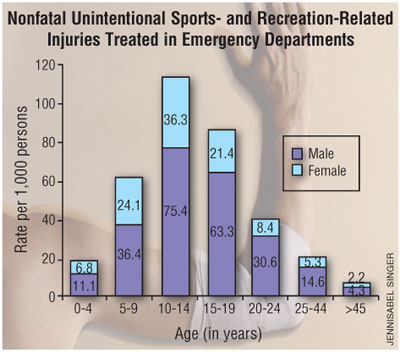US Pharm. 2006;6:16.
Each year in the United
States, an estimated 30 million children and adolescents participate in
organized sports, and approximately 150 million adults participate in some
type of non-work-related physical activity. Although these activities have
numerous health benefits, they also involve a risk of acute or chronic injury.
Incidence
The CDC has
analyzed data from the National Electronic Injury Surveillance System–All
Injury Program. In 2001, about 4.3 million sports- and recreation-related
injuries were treated in U.S. hospital emergency departments (EDs), comprising
16% of all unintentional injury-related ED visits.
Types of sports- and
recreation-related activities in which persons were engaged when injured
varied by age and sex. For boys and girls 9 years and younger, most injuries
involved playgrounds and bicycles, with scooter- and trampoline-related
injuries ranking among the top seven types. For males ages 10 to 19 years,
injuries from football, basketball, and bicycles were most common. For females
in this age range, basketball-related injuries ranked highest. For people ages
20 to 24 years, basketball- and bicycle-related injuries ranked among the
three leading types of injuries. Basketball-related injuries ranked highest
for men ages 25 to 44 years. Exercise (weight lifting, aerobics, stretching,
walking, jogging, and running) was the leading injury-related activity for
women 20 years and older and ranked among the top four types of injuries for
men in this age-group.

The most common injury diagnoses
were strains/sprains (29.1%), fractures (20.5%), contusions/abrasions (20.1%),
and lacerations (13.8%). The body parts injured most frequently were ankles
(12.1%), fingers (9.5%), face (9.2%), head (8.2%), and knees (8.1%). Overall,
2.3% of people with sports- and recreation-related injuries were hospitalized.
Medical Expenditures
According to the
2000 Medical Expenditure Panel Survey and the National Health Accounts,
injury-related medical expenditures were $117 billion in 2000, about 10% of
the total U.S. medical expenditures. A total of 16.3% of people (44.7 million)
in the U.S. reported requiring treatment for at least one injury. The
percentage was higher for males (17.3%) than for females (15.4%). By
age-group, the percentage of those reporting treatment for injury ranged from
11.9% for children younger than 10 years to 17.9% for persons ages 10 to 19
years. Among those older than 45, a greater percentage of males reported
treatment for an injury.
In 2000, $117.2 billion was
spent treating injuries among the U.S. population. Injury-attributable medical
expenditures in the U.S. population were higher for males ($59.8 billion) than
females ($57.4 billion). The greatest injury-attributable medical expenditures
($23.3 billion) were for women ages 45 to 64 years.
The true economic burden of
injuries is likely greater than reported amounts, as these numbers do not
include the value of life lost to premature mortality, insurance costs,
property damage, litigation, decreased quality of life, and diminished
functional capacity.
To comment on this article, contact
editor@uspharmacist.com.






